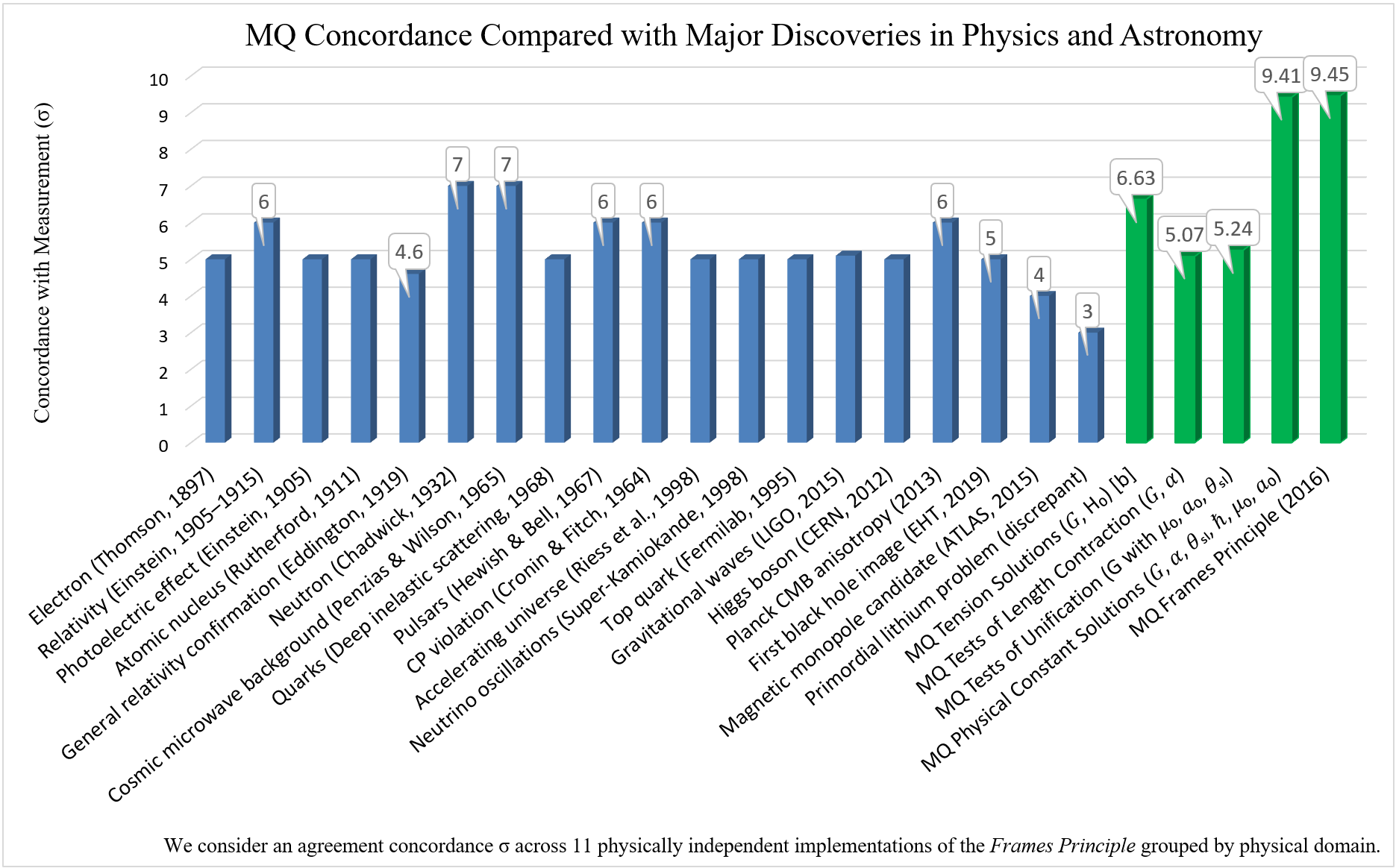We Push Back the Frontiers of Physics with
Research and Education in the Field of Informativity
Informativity is a discipline of physics that uses Measurement Quantization (MQ) to unite classical and quantum physics. When applying MQ to the boundary case of Heisenberg’s uncertainty principle three properties of measure relative to the internal frame of the universe are resolved; expressions and values for the three measures are identified and the basis for a new mathematical framework is created. For each measure - relative to the frame of the observer - there is a fundamental unit of measure and a count of that measure. When multiplied, the result maps to the IS system of units. In this way the discrete properties of phenomena are preserved.
Importantly, the discrete Internal Frame is distinguished from the non-discrete System Frame, each a description of the same phenomenon. It is the difference between these frames that allow us to resolve expressions and values for the physical constants and the laws of of nature.
The Informativity Institute™ conducts research into the field of Informativity, disseminating the results of this research to the scientific community and the public.
Measurement Quantization - proposing a new paradigm.
Every century or so, an advance is made that changes how we understand the foundations of physics. Some physical principles evolve from one mode of thought to the next. And sometimes the principles on which our understanding of nature are built, change. We call such changes a shift in paradigm.
By example, Ptolemy envisioned that the Earth was at the center of the universe. He also advanced the idea that planets moved in circles around the Earth. To account for their motions required an elaborate collection of geometric principles.
This paradigm continued until the time of Copernicus, who advanced the idea that the Earth and planets orbited the sun. He also argued for circles, so while the change was significant, it was only part of a much larger solution.
Kepler offered yet another change. His argument was that planets followed paths other than circles, namely ellipses. The need for offset circles and epicycles were no longer needed.
Newton, the father of physics, set forth the principles of calculus. He resolved many of the most fundamental laws of nature, much as we use them today. He shifted the paradigm, arguing that the laws of nature applied as much to the heavens as they did on Earth. That is, the same motions that directed the paths of planets also directed apples falling from trees.
Einstein introduced yet another shift in paradigm. He argued that the notion of measure was not absolute. He also argued that the speed of light was constant for all observers. And he proposed the equivalence principle, that the behavior of inertial and gravitational frames were equal and indistinguishable.
Measurement Quantization (MQ) offers a new paradigm for consideration. With MQ we recognize that all the existing laws of physics are resolved with respect to the discrete Internal Frame of the universe. As the System Frame of the universe has no external reference, MQ finds that the System Frame must be non-discrete. There is no fitting and expressions do not reference the other known physical constants, instead resolved needing only the radial rate of the expanding frame of the universe. When considering the difference between these descriptions, we resolve expressions and values for the physical constants and the laws of nature. Importantly, these values match our best measurements to the same precision as permitted by the respective experimental constraints.
So what is MQ? In simplest form, MQ is a physically significant nomenclature. We take existing classical expressions and write them in terms of counts nL, nM, and nT of fundamental measures - lf, mf, and tf. When written as such, expressions reduce to either counts, measures or the fundamental expression. A notable example includes Heisenberg's uncertainty principle 2nLrnMnL=nT. This expression - when considering the boundary condition - has been reduced to find that all measure terms cancel, leaving only the counts. Consider then, when discussing the Planck Scale, how could the uncertainty principle describe measure, when there are no measure terms?
In the same way, using MQ helps us recognize that space cannot be curved in a physically meaningful way. References, by definition, have no smaller features. In that a curved space is made up of smaller considerations of length, and the fundamental length reference (i.e., the Planck length relative to the observers frame) is the smallest length having physical significance, how could curved space be physically significant? MQ demonstrates that the appearance of curvature is actually a function of lost fractional counts of length with each increment in elapsed time tf. That loss, is the phenomenon of gravity.
We might ask, can we prove MQ is physically significant? Yes. This has been accomplished in multiple ways. The easiest regards the most basic prediction of MQ, that measure relative to the internal frame is quantized. If measure with respect to the Internal Frame is discrete, then would not the loss of the non-discrete portion of a more precise calculation also describe length contraction? And could this length contraction be resolved from existing measurement data?
We call this effect the Informativity differential. It is not related to relativity; it is an entirely new form of length contraction. And it can be resolved with respect to each publication of the CODATA physical constants. We've carried out the calculations in this paper, thus resolving the experimental conditions of each proposed value for G and ħ for the 2010, 2014, and 2018 CODATA publications. The results match the calculations within experimental error. We assess the relation using the sigma calculations in the chart above.
Measurement Quantization Describes the Physical Constants Using Only the Fundamental Units
Starting with a new nomenclature - reference measures and counts of those measures - three properties of measure are resolved: discreteness, count-ability and their relation to three frames of reference: the Reference, Internal, and System Frames. With that, an understanding of the physical significance of fundamental units of measure and the quantization of measure can be used to unite classical and quantum physics. What follows are expressions for the fundamental constants of nature, the laws of nature and a new mathematical approach for understanding how they are related. A few select constants from the menu above are:
Measurement Quantization Explains the Most Confounding Problems in
Physics and Cosmology
MQ is not an exercise in mathematical aerobics or fuzzy metaphysics, but a classical model delivering physically significant and verifiable descriptions of today's most pernicious cosmological puzzles:
How did the universe begin? MQ delivers a physically significant model that can be used to unravel the birth of our universe, its initial epoch which was far from rapid and the ensuing expansion collaborated by calculations that match our best measurements of the cosmic microwave background.
What is the physical significance of ΛCDM? Universal mass distribution is described by MQ using only one measured value.
What is dark matter? Whereas current theories have had mitigated success, MQ describes galactic rotation with a single classical expression (i.e. a match to Stacey McGaugh’s Milky Way MOND data with a 1.39 km/s standard deviation). There are no modifications of the known laws of physics and no fitting.
What is dark energy? MQ provides a complete description of the expansion of the universe, why it is expanding and its rate of expansion.
What is gravity? MQ is the first model to deliver a classical description of gravity, quantum in precision, written entirely in terms of motion, thus providing a complete solution to equivalence derived from first principles.


